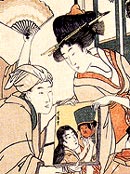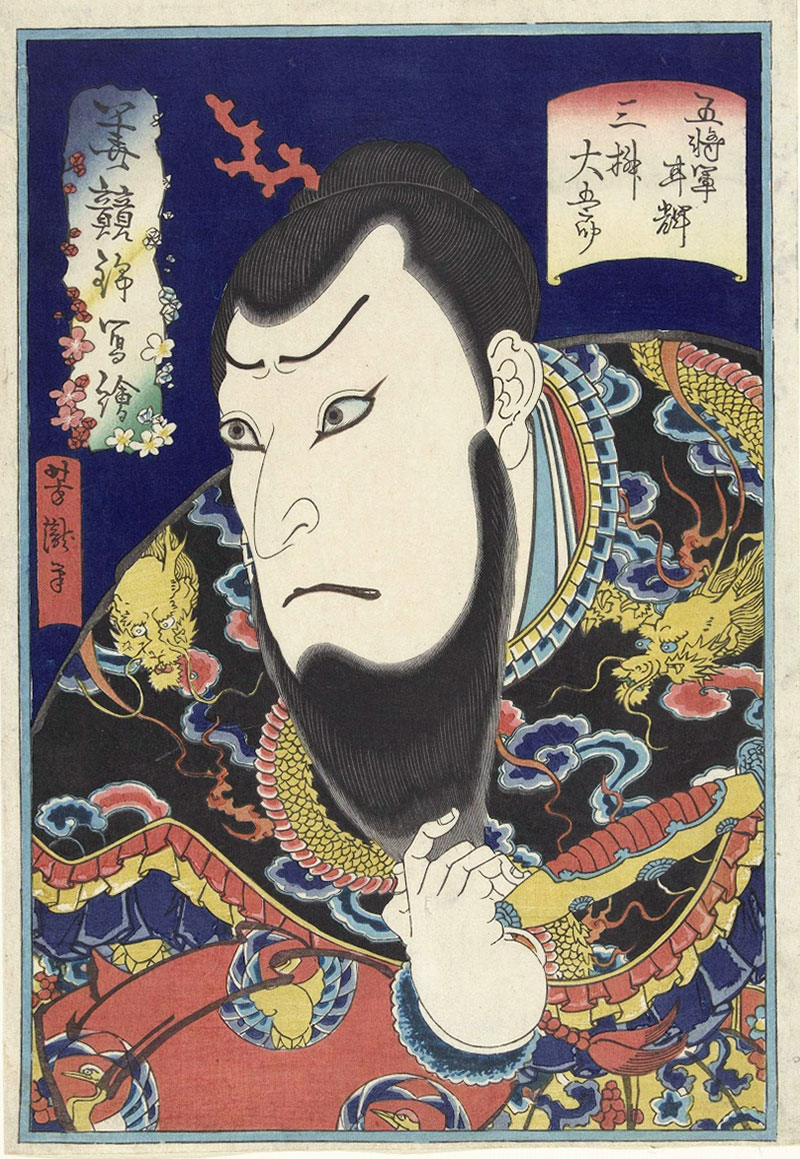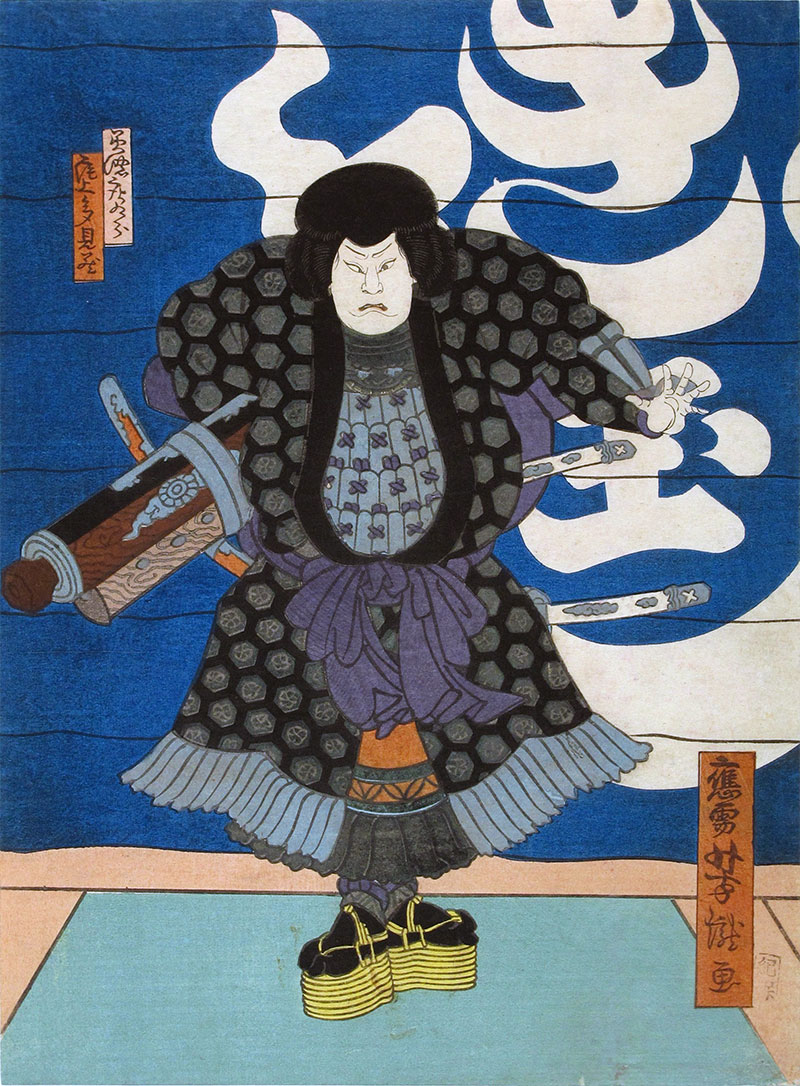

Ichiyôsai Yoshitaki (一養齋芳瀧)
|
Ichiyôsai Yoshitaki (一養齋芳瀧), who was active circa 1854-1880s, was a prolific artist who began designing woodblock prints while still a teenager. By the early 1860s, when barely into his twenties, he had already become a much sought-after print designer. His nishiki-e (full-color prints: 錦絵) included many hundreds in the chûban format, primarily yakusha-e (actor prints: 役者絵), but also fûkeiga (landscapes: 風景画) and musha-e (warrior prints: 武者絵). He also produced illustrations for nishiki-e shinbun ("color-picture news": 錦絵新聞) as well as surimono (privately commissioned and distributed prints: 摺物). From the late Edo period and especially during the 1880s, he painted many kakemono-e (hanging scroll paintings: 掛物絵) on the subjects of bijinga (beautiful women pictures: 美人画) and fûzokuga (pictures of manners and customs: 風俗画). Despite all of these varied works, Yoshitaki (and other late-period print designers) are often associated with the decline of the Osaka actor print. Indeed, although his best prints compare favorably with those of earlier artists active during the 1840s and 1850s, much of Yoshitaki's work appears rather conventional and mannered.
 |
| Ichiyôsai Yoshitaki Mimasu Daigorô IV performs the role of Gojôgun Kanki (五常軍甘輝) Kokusenya gassen (Battles of Coxinga: 國性爺合戦) Series: Hana kurabe nishiki utsushie (A true comparison of brocade flowers [actors]: 華競錦写絵) Woodblock print, ôban, 1865 |
Critics have suggested that this depreciation in quality was caused, to some degree, by the pressure to produce large quantities of designs to satisfy the demands of publishers who were eager to cash in on the popularity of the kabuki theater. This was at a time when, arguably, there were relatively few highly skilled portraitists. (The same had been said, however, about the so-called "decadence" of early nineteenth century Edo ukiyo-e). There exists an informative article written by Yoshitaki's pupil, Kawasaki Kyosen (川崎巨泉 1877–1942), describing in some detail the practices of late-period Osaka print production that sheds some light on the working habits of print designers and publishers, and the time constraints that they faced. Kyosen recounted how actor prints (yakusha-e: 役者絵) were sometimes made in Kamigata during the early years of the Meiji period (1868–1912). Publishers selected the most popular scenes from forthcoming productions and then visited the theaters on opening day, accompanied by the artists. They would set up in the middle of the floor section, where the artist sketched the actors and stage settings. Seeing this, customers attending the premieres understood that prints of the performances would soon be available, and excitement about purchasing the mementos would mount. It was more a promotional stunt than a necessity, as the artists were so familiar with the plays (except, of course, newly written works) that there was no need to view the scenes again. Still, the artist might incorporate new costumes or encounter a new face among the actors. In Yoshitaki’s case, he provided a detailed block copy (hanshita-e: 版下絵), removing the need for a block copyist (hikkô: 筆耕) to work up the sketches into final designs for carving into the woodblocks. All the subsequent work (block carving, pulling of proofs, and final color printing by artisans employed by the publisher) had to be completed in two or three days. Then multiple editions of around 200 each were printed as long as the demand lasted, with some designs selling in many thousands of impressions. Despite the pressure, Yoshitaki managed to produce some notable designs, many issued in deluxe editions, and a few of those in ôban sizes.
Around 1/1847, after the relaxation of the ban on actor prints that was part of the Tenpô Reforms (1842-47) in Osaka, the overwhelmingly dominant format was the small chûban sheet (roughly 250 x 180 mm). In the 1860s, however, there was something of a revival in the ôban sheet (roughly 370 x 280 mm), especially for deluxe editions in series. Relatively early in Yoshitaki's active period, he joined with the artist Hirokuni in providing designs for the series Hana kurabe nishiki utsushie (A true comparison of brocade flowers [actors]: 華競錦写絵). Some designs from the set include the name of the printer, suri-shi Horikame (摺師掘亀). In the example shown above, the actor Mimasu Daigorô IV performs the role of Gojôgun Kanki (五常軍甘輝) in the play Kokusenya gassen (Battles of Coxinga: 國性爺合戦), written by Chikamatsu Monzaemon (1653–1724). The drama has long been considered a bunraku (puppet theater: 文楽) masterpiece. First staged in 1715, it remains unsurpassed as the most successful play in the history of bunraku. Kabuki also produced many adaptations.
The hero of the play, Watônai Sankan (和藤内三官), is a fisherman by trade and the son of Ikkan, a former Ming minister named Tei Shiryû who had been exiled to Japan. Trained in military strategy, Watônai travels to China to aid a princess named Sendan, younger sister of the Chinese emperor murdered by the Tartars, where he fights to fulfill his father's promise to restore the Ming dynasty and place Sendan on the throne. In the theatrical adaptation, Watônai and Ikkan travel to China, where they find Ikkan's daughter and Watônai's half-sister, Kinshôjô, married to a general named Gojôgun Kanki, of Ming ancestry but allied with the Tartars. Kinshôjô, loyal to her father and Watônai, agrees to ask Kanki to join Watônai, but she has them wait outside the Lion Castle for a sign of her husband's intentions: a powder — white for "yes" and red for "no" — to be tossed into cascading water flowing down to the castle moat. Kanki is sympathetic to her request but cannot take advice from a woman on military matters, as it would bring shame upon himself and his descendents. He is also bound by a promise he has made to the Tartars to kill Watônai. Always the warrior, Kanki considers murdering his wife to quell rumors of his being a coward, but is dissuaded by Kinshôjô's stepmother (Watônai's Japanese mother, who was allowed to enter the castle to plead their cause). The play's most famous scene is called beni nagashi shishigajô ("the red signal inside the castle") in which Kinshôjô stabs herself and, in place of the red powder, lets her blood flow into the conduit. Her death frees Kanki to fight the Tartars. Upon seeing the "red signal," Watônai bursts into the Lion Castle to confront Kanki, but soon the two become allies and Watônai is given the name Kokusenya, Lord of Enpei.
 |
| ôju [by request] Yoshitaki ga (應需芳滝画) Onoe Tamizô II (尾上多見蔵) as Mino no Shôkurô (美濃庄九郎) Keisei ômonguchi (Courtesan at the great gate of the pleasure quarter: 契情廓大門) Naka Theater, Osaka, 1/1865 Woodblock print, chûban |
Yoshitaki was a prolific artist when working in the chûban format. Often, he was not always well-served by the prevailing modes of actor portraiture and somewhat garish colorants. Many of his prints seem harsh and cluttered. But among his many hundreds (possibly more than a 1,000) designs, there were a large number of eye-catching designs. In the deluxe-edition example shown here, published in 1/1862, the actor Onoe Tamizô II (尾上多見蔵) performs as Mino no Shôkurô (美濃庄九郎) in Keisei ômonguchi (Courtesan at the great gate of the pleasure quarter: 契情廓大門 also written as けいせい廓大門) at the Naka Theater, Osaka. The print is signed ôju [by request] Yoshitaki ga (應需芳滝画).
The libretto of Keisei ômonguchi has apparently not survived, but it seems to be an adaptation of ômonguchi yoroi kasane (Armored assault at the entrance to the great gate: 大門口鎧襲) written by Namiki Sôsuke in 12/1743, which premiered at the ônishi Theater in Osaka). The drama features a complicated saga in which Shôkurô plots against Shinkurô, the murderer of his father, and wherein some of the characters take on disguises and false identities during the intrigues fueling the plot twists.
Onoe Tamizô II (1799-1886; 二代目 尾上多見蔵), the son of a theater hairdresser, was a skillful dancer and versatile actor. He had a long career. When he was barely 20 years of age, Tamizô began an apprenticeship with the great Onoe Kikugorô III (1784-1849; 三代目 尾上菊五郎) in Edo for three years, then returned to Osaka in 1823. (He had several sojourns in Edo thereafter.) In Osaka he was championed by a coterie of artists in Osaka in the mid 1820s, led by Gatôken (Toryûken) Shunshi, who specialized in depicting him in many performances. Early on he worked mostly the middle theaters in Osaka, but by 1833, he was also appearing in the larger theaters, such as the Kado and Naka. Tamizô tended to be a flamboyant showman and was short, overweight, and reputedly illiterate. (His weight problem is evident in portraits issued later in his career, as in the print illustrated here.) Nevertheless, Tamizô was a successful actor on the Osaka and Edo stages for more than 60 years.
For more about this particular Yoshitaki design, see my text at Yoshitaki-Tamizô. Also see Fading of a Yoshitaki Print for another design by the artist.
Yoshitaki's Names
Surnames:
Nakai (中井)
Sasaki (笹木)
Personal Name (jinmei):
Tsunejirô (恒次郎 also read Kôjirô)
Art Name (geimei):
Yoshitaki (芳瀧)
Art Pseudonyms (gô):
Ichiyôsai (一養齋)
Ichiyôtei (一養亭)
Ittensai (一点齋)
Jueidô (壽榮堂)
Noriya (糊家)
Satonoya (里の家)
Yôsui (養水)
Pupils of Yoshitaki
Yoshitaki seems to taught only a few students, among them:
Kawasaki Kyosen (川崎巨泉 1877–1942), esp. prints and paintings depicting "images of toys" (omocha-e: 玩具絵)
Yoshikage (芳景 act. c. 1872-96)
Yoshioka (芳陸 act. c. 1875-1880s)
Yoshimitsu (芳光 act. c. 1873-90)
Yoshitaka (芳鶴 act. c. 1873-74)
©1999-2021 by John Fiorillo
BIBLIOGRAPHY
- Keyes, R. and Mizushima, K.: The Theatrical World of Osaka Prints. Philadelphia: Philadelphia Museum of Art, 1973, pp. 198-99, no. 79.
- Kitagawa, Hiroko: Kamigata yakusha-e shûsei (Collection of Kamigata actor prints), Vol. V. Osaka: Ikeda Bunko, 2005.
Viewing Japanese Prints |